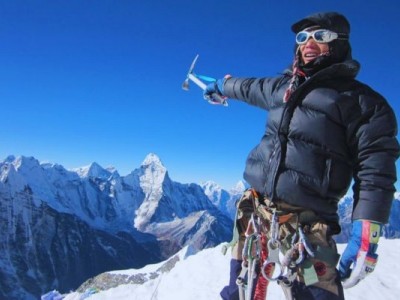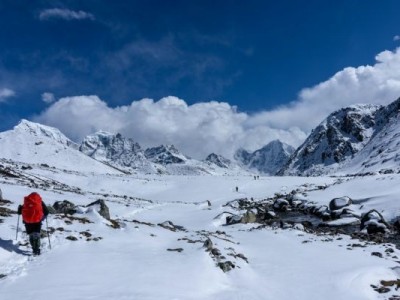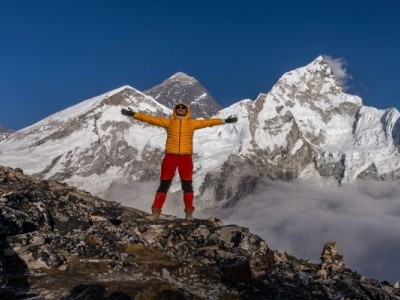Upper Dolpo is one of the most beautiful and off-the-beaten-path trekking destinations in Nepal, and when it comes to planning your Upper Dolpo trek accommodation, preparation is key. This remote area of the Himalaya has very little infrastructure compared to the more popular trekking areas, so planning for accommodation is a must for any trekker. You will find three main types of accommodation in Upper Dolpo while trekking: basic teahouses with some comfort, authentic homestays with cultural opportunities, and camping experiences under the stars. Each of the basic overall accommodation types will have unique benefits and drawbacks, from the locality of village homestays, which provide local hospitality, to the portability of camping, which gives you the choice of where you sleep at night. Knowing all these options, you can prepare for your journey and ensure your Upper Dolpo trekking accommodation guide experience is as expected, while adhering to the sensitivities of the mountain ecosystem.
Table of Contents
Overview of Accommodation on Upper Dolpo Trek
Importance of Planning Where to Stay
When planning your accommodation on Upper Dolpo trek, remember that this region is remote, so there are key differences to consider. Unlike other trekking circuits, which all have lodges every few hours of walking, Upper Dolpo has limited lodges that fill up quickly during peak season. Your accommodation will shape your trip according to your budget and how both locals and fellow trekkers interact with you throughout your journey.
Shelter is important in the region; the challenging climate and geography of the terrain always necessitate planning for shelter for safety and comfort. The nature of the ever-changing weather at high elevations means you want reliable lodges to allow for proper rest and recuperation. Planning will also give you a better understanding of the distances covered each day, so that you know where the next stops are, and to ensure you do not end up in the middle of nowhere without proper shelter.
What Trekkers Can Realistically Expect in Dolpo
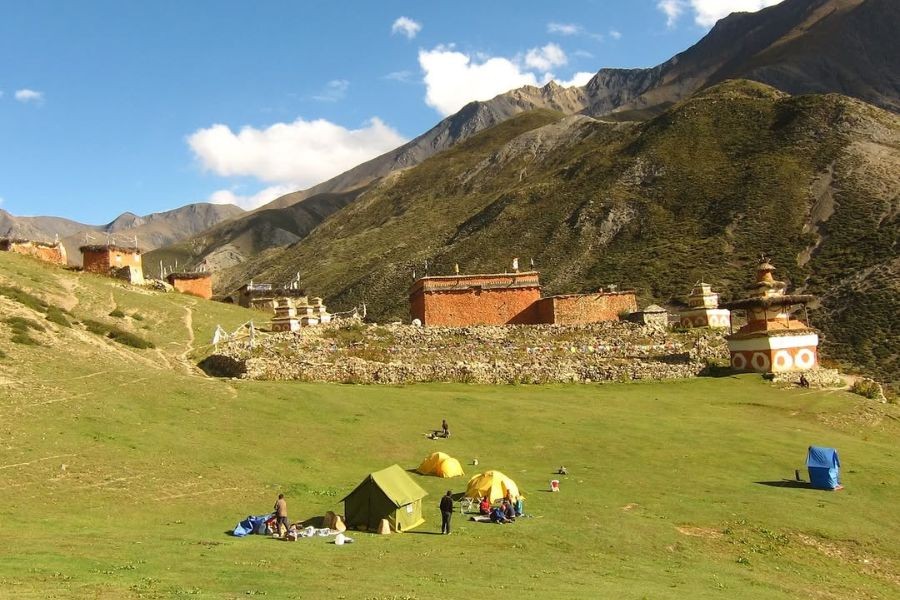
Trekking involves adjusting your expectations regarding the standard of accommodation in Upper Dolpo. Accommodations are comparably below the standards of both hotels in urban areas and popular mountain lodges and lodges. It is basic accommodation and will generally include shared bathroom facilities, limited heating, and basic bedding.
In most cases, there will be intermittent electricity or it will only be operational during the noted hours by solar panel or generator. Hot water can seldom be considered a non-optional luxury; turning on hot water can require additional payment or not unavailable.
Internet connectivity moves between intermixed and extremely limited, which will allow you to really 'switch off' from anything digital and be really present in the mountain life you are experiencing.
Teahouse Availability in Upper Dolpo
Dolpo Teahouse Availability Along Trekking Routes
The options for Dolpo teahouses vary greatly between trek routes, as some areas may have several teahouses and others very few or none at all. Parts of the main trekking routes between the larger villages will likely have one or two basic teahouses that open seasonally, with local families only able to manage a teahouse with their local circumstances as well.
No teahouse availability is not anticipated beyond north of. Key villages in Upper Dolpo, like Dunai, Tarakot, and Dho Tarap, all have teahouses, as they will likely have multiple options and will be key stopping points for trekkers. There will be remote sections when traveling between those villages where there will not be any permanent accommodation, and trekkers may have to camp or rely on local homestays. If relying on teahouse accommodation in Upper Dolpo, it is always advisable to carry a backup form of shelter.
Facilities Inside Tea Houses
Teahouses on the Upper Dolpo trek provide important and basic services and amenities, but they are programmatic in their approach and not designed to provide luxury comfort. Rooms mostly feature simple wooden beds, a basic mattress, and cheap pillows. A sleeping bag is strongly recommended because of the issues regarding warmth and hygiene.
Teahouses have shared toilets hired by more than one guest and typically located outside of the main buildings. Most teahouses have shared dining spaces for meals and conversation in the evening. Teahouses provide heating by wood-burning stoves and are the warmest parts of the teahouse when it is cold in the surrounding mountains at night.
Typical Dolpo Lodge Prices Per Night
Dolpo lodge prices are quite cheap relative to prices around the world, and they can be along with more remote lodge experiences and the volume of demand supplied. Basic teahouse accommodation can generally expect to cost you between $5-15 per night per person, based on season and location.
Traditionally, prices will rise based on high demand in peak seasons such as spring and autumn. The supply of lodges immediately diminishes when demand quickly outpaces supply. Lodges that include meals with packages can prove to offer better dollar value than just accommodation. Make sense? Always be polite in letting them know when a price seems unacceptable or unreasonable, and also remember that the higher price reflects the amount of energy it takes to keep the lodge operational in remote areas of the mountain.
Homestays in Upper Dolpo
What Dolpo Homestays Offer
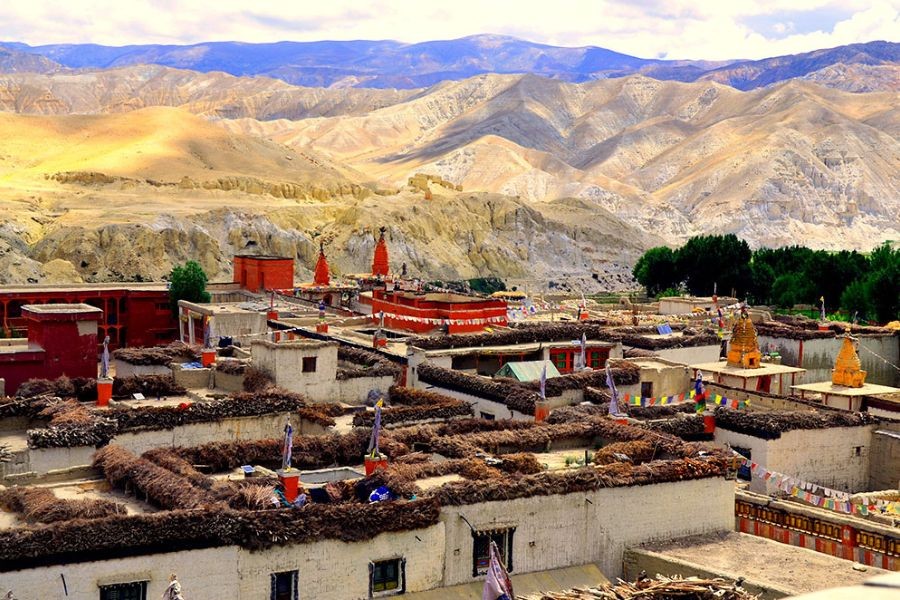
Dolpo homestay experiences are a real cultural immersion that standard accommodation simply can't replicate. Local families "homestay" trekkers in their homes, share meals that include their local foods and customs, and go about their daily living, usually to the delight of their guests. These homestay arrangements will provide you with access to genuine contact with mountain communities and knowledge of ancient Tibetan Buddhist culture.
Homestay accommodations generally include the use of simple sleeping arrangements (usually within the family compound), shared meals with local foods, and participation in normal daily living activities. Families do not treat their guests as commercial customers but as temporary members of their household.
Cultural Experience with Local Families
Staying with a local family creates meaningful cultural exchanges that take your trekking experience beyond mere tourism. Guests can observe traditional farming practices, take part in traditional religious customs, and learn about the use of medicinal plants with traditional ethnic mountain communities.
You could even spend an evening sharing stories around the wood fire with the family, discussing challenges in their region, and gaining valuable appreciation of the mountain peoples' resilience. Children in homestay families are likely to use their English on the guests, which would immediately lead to positive interactions for all parties.
Pros and Cons of Staying in Homestays
Homestays provide unique cultural authenticity and personal connections to local communities. You will enjoy home-cooked meals, warm hospitality, and stories you won’t find anywhere else. These experiences often stand out as some of the top moments of a trek, they provide trail memories that will last long after you’ve left the mountain views behind. However, these experiences may be an inconvenience to some trekkers. Privacy may be compromised, there may not be any of the amenities you have come to expect, language barriers can make things awkward, and dietary restrictions could be difficult to manage. Further, differences in sanitation can also differ from what you are used to, and assume that you are flexible and can reflect cultural sensitivity.
Camping on the Upper Dolpo Trek
Why Camping Is Common in Dolpo
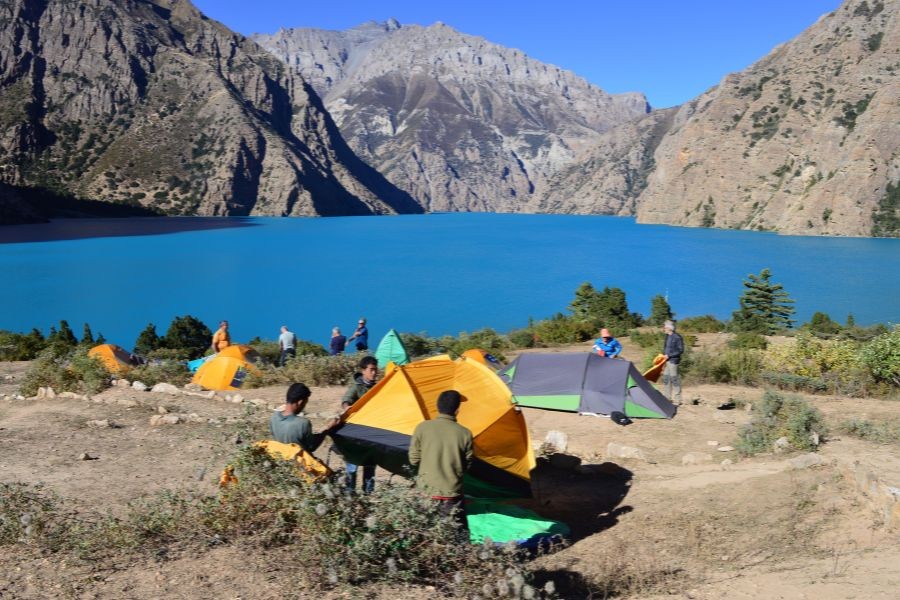
Due to a lack of permanent lodging in the remote reaches of Upper Dolpo, camping is essential. Just like many other trekking routes, there are parts of the Dolpo where you will trek through uninhabited valleys that only allow for camping accommodation. Camping is the most flexible style of accommodation if you want to be free from the constraints of timing and travel on foot over the various routes.
Tent camping will take you into areas of wilderness that would be impossible to get to from a fixed accommodation base. You will have total mountain solitude, phenomenal sunrises and sunsets, and satisfaction knowing that you have moved across the land (mountains and fields) self-sufficiently.
- Related article: Best Time to Trek Upper Dolpo, Nepal - Spring & Fall Guide
Necessary Equipment and Crew Support
Camping involves a serious amount of packing and gear that will withstand the weather, tents, sleep systems, cooking equipment, and portable shelter systems. Most trekkers are hiring the local guides with porters and are relying on the guide and porter to take care of the camping logistics, carry items, and take care of meals.
Professional trekking outfitters usually going to supply gear, and they are designed for serious mountain conditions. Most overnight sleeping gear consists of expedition tents, insulated sleeping pads that are insulated, and cooking systems designed to work at altitude.
Best Camping Spots
Good camping spots will be flat ground, with water, and away from the wind. Campsite locations along the route to Shey Phoksundo lodges will contain options with awesome lake views and more protected spaces. Higher up in open alpine meadows provides great mountain viewing but requires constant weather checks.
Always camp in designated areas, or you will need to get permission from the local villages if you are adjacent to one when you camp. Practice no-trace camping, especially in unspoilt mountain sites, where human activity can be seen long in the future.
Accommodation at Shey Phoksundo and Key Villages
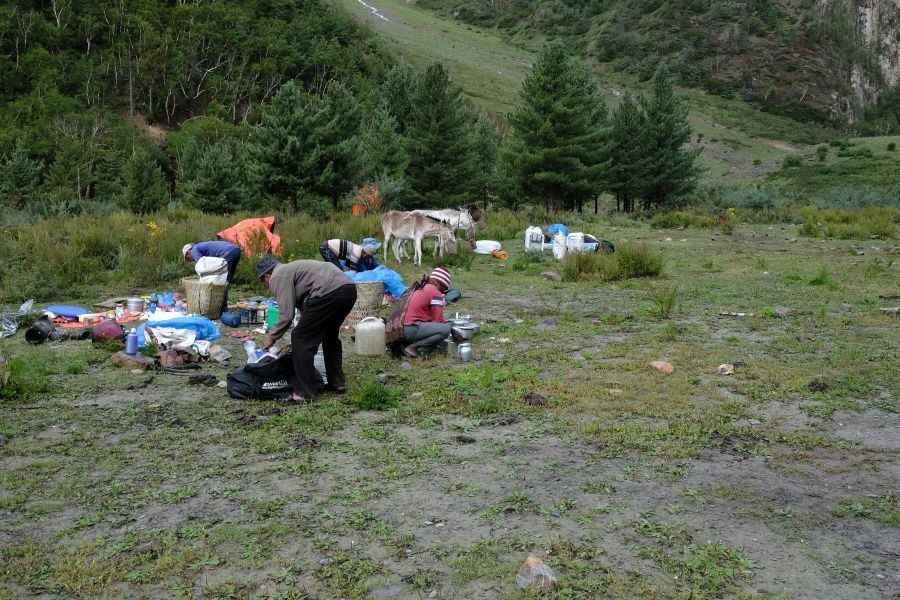
Shey Phoksundo Accommodation Options
The accommodation scene in Shey Phoksundo revolves around basic lodges near the famous turquoise lake. Several simple guesthouses provide basic occupancy, but remain basic with separate bathrooms; heat is limited as well.
The area may have basic accommodation, but the stunning surrounding natural beauty more than makes up for it. Waking up next to Nepal's deepest lake with massive peaks cast into pristine water is a memorable experience, no matter the simplicity of your accommodation.
Popular Stopovers and Their Facilities
Important villages along the trekking routes have (often limited) accommodation of differing standards. Dunai is a major town with several lodging options and basic supplies. Tarakot is a basic mid-route lodging option; the facilities in Tarakot are very simple, but clean.
Dho Tarap presents unique cultural opportunities, where the traditional stone houses of the area have been converted to make very basic guesthouses. Each of the places provides basic services and accommodations for travelers, and each has its opportunities for local flavor and traditional architecture.
Where to Stay in Upper Dolpo's Remote Villages
Where you stay in Upper Dolpo will depend on which route you take and the time of year you travel. When traveling to more remote villages, the village may only have homestays available, or it may simply require planning to communicate through local contacts. Some villages, for example, have community lodges that villagers have cooperatively operated. Research accommodation options for your chosen route well in advance. Local trekking agencies will be up to date with current information on seasonal closures, new builds, or instances when accommodation goes offline altogether.
- Related article: Upper Dolpo Trek Packing List: Essential Trekking Gear Guide
Food and Meal Options Along the Trek
Typical Meals in Teahouses and Homestays
While mountain dining emphasizes hearty, warming meals that will sustain long days of trekking, food will still act as an opportunity for variety—and will also reflect the local culture. The standard meal at many guesthouses is dal bhat (rice and lentils), which is usually served with vegetable curries and pickles. There will often be Tibetan plate influences, including thukpa (noodle soup) or momos (dumplings), which add comfort.
Breakfast will often include porridge and eggs with Tibetan bread and honey or jam. Tea culture reigns, and there will likely be ways to enjoy local flavor, including butter tea, milk tea, and coffee.
Dietary Considerations for Trekkers
Vegetarian options will remain available, and they will probably be some of the freshest options available in remote settings. Meat will be available, but it may be less fresh due to preservation issues at high altitudes. Let your accommodation know your specific dietary restrictions ahead of time.
As to food safety, it’s always a consideration in mountain environments, where refrigerated storage is generally limited. Stick with hot, freshly prepared, well-cooked meals and avoid any raw vegetables or dairy products that may have been spoiled while being transported to remote locations.
What to Expect When Camping
Camping meals rely entirely on your guides' ability to cook and the ingredients available. All the professional trekking companies have experienced cooks who will create healthy, tasty meals using portable kitchens with ingredients found in the area.
Expect several simple meals that are not fancy but enjoyable, such as rice, pasta, and vegetables with the occasional meat dish. Most dinners will start with a hot soup, which is nice for warming you up and providing fluid intake after a long day's trek through the dry mountain air.
Essential Tips for a Comfortable Stay in Dolpo
Electricity and Charging Availability
Electrical service is scarce in Upper Dolpo, limited to evenings via solar panels or diesel generators; so pack at least portable power banks or solar charging devices to keep essential electronics powered.
Upgrades to your itinerary may include options for charging devices, for which many charging sites charge basic fees (typically $2-5) for charging your device. So plan your itinerary with your power needs in mind while prioritizing essential devices (headlamps, GPS, emergency communications) over entertainment devices.
Clean Water and Hygiene Suggestions
Water purification becomes a vital consideration for health and safety on your trek. Plan to carry good water purification tablets or filtering systems, as bottled water is likely limited and environmentally unsound in remote areas.
Basic hygiene facilities will be there to accommodate you, but adjust your commonplace routine to meet mountain-stipulated limits. Bring biodegradable soap, quick-dry towels, and hand sanitizer to maintain some basic hygiene when you may not have access to traditional washing facilities.
Booking and Preparation Advice
Reserve your lodgings with trustworthy local trekking companies like "Himalayan Ecological Trekking" who have ongoing relationships with lodge owners and homestay families. It’s always better to book ahead, especially in peak season when beds will be difficult to come by.
Expect to accept basic standards of service, and ensure you have the necessary sleeping equipment, toiletries, and contingency arrangements in place, in case of emergencies. Planning may be adjusted as better flexibility will provide for unexpected accommodation changes or local weather conditions.
Best Accommodation Option for Your Trek
Comparing Teahouses, Homestays, and Camping
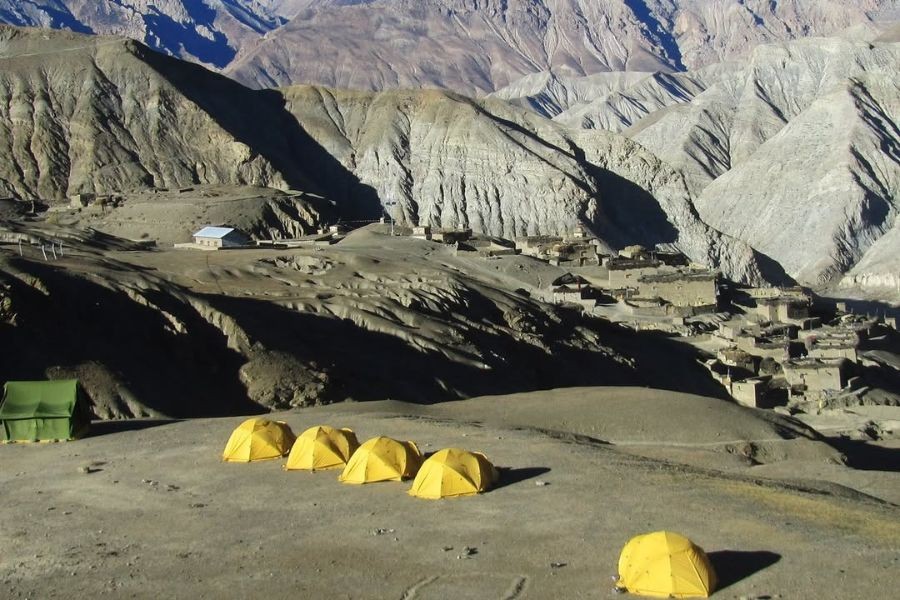
Each lodging type has its own merits depending on your trekking style and comfort. Teahouses provide the most certain option for comfortable and social accommodations with other trekkers. They have fixed locations and take little equipment (limited cultural immersion).
Homestays provide real cultural experiences and personal engagement with local populations. They provide local eating experiences and real hospitality, but may not have privacy amenities. Language and cultural differences require patience and flexibility.
Camping will offer the most flexibility and access to wilderness areas in ways that are not accessible by fixed accommodations. They allow for complete solitude and have fabulous locations, but require more equipment, harder skills, and reasonable levels of comfort with difficult conditions.
How to Choose Based on Comfort, Budget, and Adventure Preference
Budget travelers are drawn to teahouses and homestays, which cost substantially less than fully-supported camps. Camping could represent the best value for money for groups sharing equipment costs and guide fees, as they will be able to find more pristine wilderness areas.
If comfort is a priority, teahouses are best suited for bigger villages where you can accept basic accommodations, social interaction, and the comfort of knowing where you will be staying.
If seeking adventure, camping would be preferred for the ultimate flexibility and access to more remote areas of the wilderness that no fixed accommodation can provide.
When selecting accommodation types, consider your fitness level, sleeping systems preferences, and cultural aspirations. Many great treks combine a variety of accommodations: teahouses in villages to cook meals, homestays to immerse the trekkers in culture, and camping for more culturally remote sections of the wilderness.
FAQs
How far in advance should I book Upper Dolpo trek accommodation?
You should book accommodation in Upper Dolpo 2-3 months ahead of time. This is especially important during peak trekking seasons (March-May and September-November). There are very few options for accommodation, and they sell out quickly. By booking in advance, you will have a better chance of finding accommodation and making proper plans.
What should I expect to pay for accommodation in Upper Dolpo?
Teahouse-style accommodation will cost around $5-15 per night for basic accommodation in Upper Dolpo, and homestays will cost $8-20 per night, which includes meals. Camping expedition costs vary widely depending on the number of people in the group, and menu deliveries and services included. The costs can go up considerably depending on how remote the area is and during peak season.
Are there luxury accommodation options in Upper Dolpo?
Upper Dolpo does not have luxury accommodation. Because of the remoteness of the region and access, all accommodation will only be basic. Concentrate on the natural beauty of the surroundings and the cultural activities as opposed to luxury accommodation.
Can I find accommodation on the day without booking ahead of time?
It is theoretically possible to find accommodation without booking ahead of time, particularly in the low season; however, it is risky because of limited accommodation options. There is always the possibility that a village does not have available jams, and the person is left with no option but to pitch a more costly last-minute camp, or travel could turn dangerous, and it is better to be stuck in a village for the night.
What is the best accommodation option for a solo trekker?
Teahouses and homestays are better options for solo trekkers because they allow for social interaction and flexible cost sharing. Solo camping is only for trekkers with extensive mountaineering experience and considerably want to camp, carry an emergency tent, and are capable of making emergency decisions that most trekkers would not be able to make.
Conclusion
Your accommodation strategy for your Upper Dolpo trek will greatly affect the success and enjoyment of your mountain adventure. Whether you choose the community atmosphere that a teahouse provides, a stay with an authentic cultural experience with a homestay, or the freedom of wilderness camping, each option has unique advantages for different styles of trekking and preferences that could supplement any experience. The remoteness of the Upper Dolpo region requires diligent preparation, reasonable expectations, and flexibility in your accommodation planning, in case of weather and local conditions.
Your accommodation options should consider your comfort level, your budget, your adventure objectives, and, where possible, honor the hopes of the local people of Upper Dolpo and the pristine mountain environment. Remember that basic accommodation and challenging conditions are part of the true and unique adventure experience of Upper Dolpo, with stories and experiences to be had that are impossible to replicate in other trekking areas with more infrastructure. The very best accommodation on the Upper Dolpo trek is entirely a personal choice based on comfort needs, physical ability, and your desire to experience the simplicities of mountain life and wilderness.
Are you ready to venture into the remote wilderness of Upper Dolpo?
Let Himalayan Ecological Trekking take you on this incredible adventure with local knowledge and sustainable trekking practices.
Inquire Now: [email protected]
Expert Consultation: WhatsApp: +977 9851006023 (Bikesh)
Familiar trekking Packages of Upper Dolpo:
.jpg)
